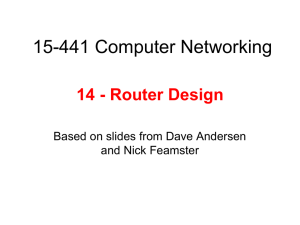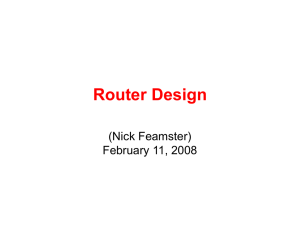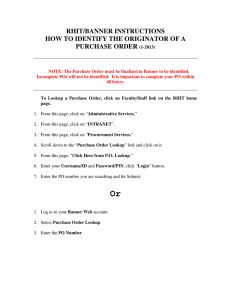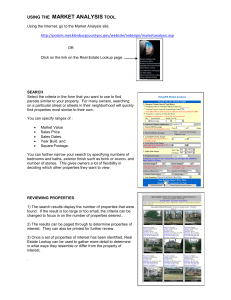15-441 Computer Networking 14 - Router Design and Nick Feamster
advertisement
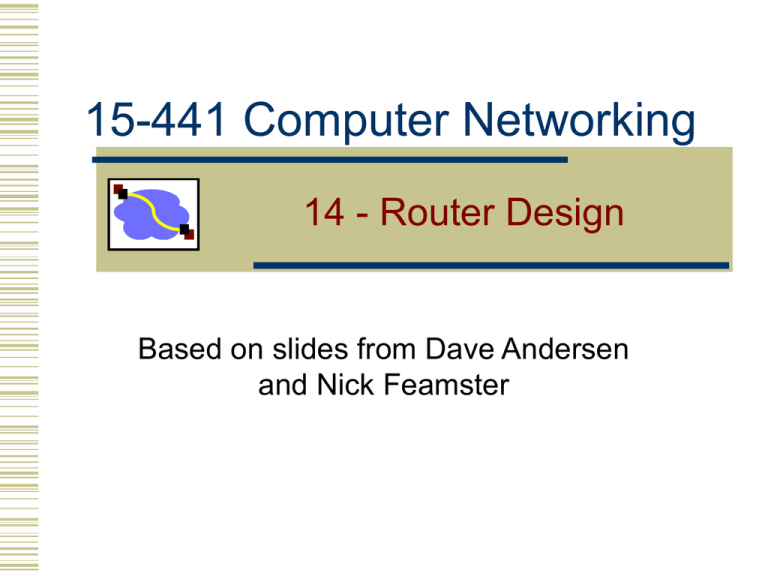
15-441 Computer Networking 14 - Router Design Based on slides from Dave Andersen and Nick Feamster Overview • The design of big, fast routers • Partridge et al., A 50 Gb/s IP Router • Design constraints • Speed • Size • Power consumption • Components • Algorithms • Lookups and packet processing (classification, etc.) • Packet queuing • Switch arbitration 2 News of the Week Oct 12, 2011, Silicon.com on BlackBerry: "The outage has been caused by the failure of a core switch on the network that connects a major RIM datacentre in Slough to other RIM datacentres worldwide, O'Neill said. 'On Monday we thought we had identified the root cause - a core switch that connects our datacentres worldwide - and what we did yesterday was to identify that and change the components and the infrastructure, and brought the BlackBerry service back again overnight. ...'..." Mentions 20PB/month. BlackBerry says service is fully restored after 3-day outage. More News Oct 12, 2011. Gordon Peterson says: "I found that the Internet is MISROUTING IP addresses... in this case, an entire block of 255 (at least) IP addresses belonging to the U.S. State Department (!!) (when tracerouted) never get delivered to the machine the DNS lookup gives, but instead are being misrouted to another machine that seems to be outside the USA (!)... and which (worse) it appears that is at least accessible to what appears to be a Russian-based organized crime organization." Summary of Routing Functionality • • • • Router gets packet Looks at packet header for destination Looks up routing table for output interface Modifies header (TTL, IP header checksum) Why? • Passes packet to output interface 5 Generic Router Architecture Header Processing Data Hdr Data Lookup Update IP Address Header IP Address 1M prefixes Off-chip DRAM Hdr Queue Packet Next Hop Address Table Buffer Memory 1M packets Off-chip DRAM 6 What’s In A Router • Interfaces • Input/output of packets • Switching fabric • Moving packets from input to output • Software • • • • Routing Packet processing Scheduling Etc. 7 First Generation Routers Off-chip Buffer Shared Bus CPU Route Table Buffer Memory Line Interface Line Interface Line Interface MAC MAC MAC Typically <0.5Gb/s aggregate capacity 8 What a Router Chassis Looks Like Cisco CRS-1 Juniper M320 19” 6ft 17” Capacity: 1.2Tb/s Power: 10.4kW Weight: 0.5 Ton Cost: $500k 3ft 2ft Capacity: 320 Gb/s Power: 3.1kW 2ft 9 What a Router Line Card Looks Like 1-Port OC48 (2.5 Gb/s) (for Juniper M40) 4-Port 10 GigE (for Cisco CRS-1) 10in 2in Power: about 150 Watts 21in 10 Big, Fast Routers: Why Bother? • • • • Faster link bandwidths Increasing demands Larger network size (hosts, routers, users) More cost effective 11 First Generation Routers Off-chip Buffer Shared Bus CPU Route Table Buffer Memory Line Interface Line Interface Line Interface MAC MAC MAC Typically <0.5Gb/s aggregate capacity 12 Innovation #1: Each Line Card Has the Routing Tables • Prevents central table from becoming a bottleneck at high speeds • Complication: Must update forwarding tables on the fly. 13 Control Plane & Data Plane • Control plane must remember lots of routing info (BGP tables, etc.) • Data plane only needs to know the “FIB” (Forwarding Information Base) • Smaller, less information, etc. • Simplifies line cards vs the network processor Generic Router Architecture Data Hdr Header Processing Lookup IP Address Buffer Manager Update Header Hdr Header Processing Lookup IP Address Hdr Interconnection Fabric Header Processing Lookup IP Address Address Table Buffer Manager Update Header Address Table Data Hdr Data Hdr Buffer Memory Address Table Data Data Update Header Buffer Data MemoryHdr Buffer Manager Buffer Memory 15 Second Generation Routers CPU Route Table Buffer Memory Bypasses memory bus with direct transfer over bus between line cards Line Card Line Card Line Card Buffer Memory Buffer Memory Buffer Memory Fwding Cache Fwding Cache Fwding Cache MAC MAC MAC Typically <5Gb/s aggregate capacity Moves forwarding decisions local to card to reduce CPU pain Punt to CPU for “slow” operations Bus-based • Improvement over first generation: • Cache bits of forwarding table in line cards, • Send directly over bus to outbound line card • But shared bus was big bottleneck • E.g., modern PCI bus (PCIx16) is only 32Gbit/sec (in theory) • Almost-modern Cisco (XR 12416) is 320Gbit/sec. • Ow! How do we get there? Innovation #2: Switched Backplane • Every input port has a connection to every output port • During each timeslot, each input connected to zero or one outputs • Advantage: Exploits parallelism • Disadvantage: Need scheduling algorithm 18 Third Generation Routers “Crossbar”: Switched Backplane Line Card CPU Card Line Card Local Buffer Memory Routing Table Local Buffer Memory Fwding Table Fwding Table Periodic MAC MAC Control updates Typically <50Gb/s aggregate capacity What’s so hard here? • Back-of-the-envelope numbers • Line cards can be 40 Gbit/sec today (OC-768) • Undoubtedly faster in a few more years, so scale these numbers appropriately! • To handle minimum-sized packets (~40b) • 125 Mpps, or 8ns per packet • But note that this can be deeply pipelined, at the cost of buffering and complexity. Some lookup chips do this, though still with SRAM, not DRAM. Good lookup algos needed still. • For every packet, you must: • Do a routing lookup (where to send it) • Schedule the crossbar • Maybe buffer, maybe QoS, maybe filtering by ACLs Crossbar Switching • Conceptually: N inputs, N outputs • Actually, inputs are also outputs • In each timeslot, one-to-one mapping between inputs and outputs. • Crossbar constraint: If input I is connected to output j, no other input connected to j, no other output connected to input I • Goal: Maximal matching S * (n) arg max( L (n) S (n)) T Traffic Demands S (n) L11(n) Maximum Weight Match Bipartite Match LN1(n) 21 Head-of-Line Blocking Problem: The packet at the front of the queue experiences contention for the output queue, blocking all packets behind it. Input 1 Output 1 Input 2 Output 2 Input 3 Output 3 Maximum throughput in such a switch: 2 – sqrt(2) What can we do about it? Put queues on output side. Separate queues for each output. M.J. Karol, M. G. Hluchyj, and S. P. Morgan, “Input Versus Output Queuing on a Space-Division Packet Switch,” IEEE Transactions On Communications, Vol. Com-35, No. 12, December 1987, pp. 1347-1356. 22 Combined Input-Output Queuing • Advantages • Easy to build • Better throughput input interfaces output interfaces Crossbar • Disadvantages • Harder to design algorithms • Two congestion points 23 Solution: Virtual Output Queues • Maintain N virtual queues at each input • one per output Input 1 Output 1 Input 2 Output 2 Output 3 Input 3 N. McKeown, A. Mekkittikul, V. Anantharam, and J. Walrand, “Achieving 100% Throughput in an Input-Queued Switch,” IEEE Transactions on Communications, Vol. 47, No. 8, August 1999, pp. 1260-1267. 24 Early Crossbar Scheduling Algorithm • Wavefront algorithm Aij = 1 indicates that card i has a packet to send to card j Problems: Fairness, speed, … 25 Alternatives to the Wavefront Scheduler • PIM: Parallel Iterative Matching • Request: Each input sends requests to all outputs for which it has packets • Grant: Output selects an input at random and grants • Accept: Input selects from its received grants • Problem: Matching may not be maximal • Solution: Run several times • Problem: Matching may not be “fair” • Solution: Grant/accept in round robin instead of random 26 Scheduling and Fairness • What is an appropriate definition of fairness? • One notion: Max-min fairness • Disadvantage: Compromises throughput • Max-min fairness gives priority to low data rates/small values 27 Max-Min Fairness • A flow rate x is max-min fair if any rate x cannot be increased without decreasing some y which is smaller than or equal to x. • How to share equally with different resource demands • small users will get all they want • large users will evenly split the rest • More formally, perform this procedure: • Split resources among all customers with unsatisfied demands • No customer receives more than requested • Iterate as long as there are more resources and unsatisfied demands 28 Example • Demands: 1.9, 2.6, 4, 5; capacity: 10 • 10/4 = 2.5 • Problem: 1st user needs only 1.9; excess of 0.6, • Distribute among 3, so 0.6/3=0.2 • now we have allocs of [2, 2.7, 2.7, 2.7], • leaving an excess of 0.1 for cust #2 • divide that in two, gets [2, 2.6, 2.75, 2.75] • Maximizes the minimum share to each customer whose demand is not fully serviced 29 IP Address Lookup • Challenges: Longest-prefix match (LPM). Tables are large and growing. Lookups must be fast. 35 IP Lookups find Longest Prefixes 128.9.176.0/24 128.9.16.0/21 128.9.172.0/21 65.0.0.0/8 0 128.9.0.0/16 128.9.16.14 142.12.0.0/19 232-1 Routing lookup: Find the longest matching prefix (aka the most specific route) among all prefixes that match the destination address. 36 IP Address Lookup • Challenges: Longest-prefix match (LPM) Tables are large and growing. Lookups must be fast. 37 Address Tables are Large Note: FIB = Forwarding Information Base 38 IP Address Lookup • Challenges: Longest-prefix match (LPM) Tables are large and growing. Lookups must be fast. 39 Lookups Must be Fast Year Line 40B packets (Mpkt/s) 1997 622Mb/s 1.94 OC-12 1999 2.5Gb/s 7.81 OC-48 2001 10Gb/s 31.25 OC-192 2003 40Gb/s 125 OC-768 Cisco CRS-1 1-Port OC-768C (Line rate: 42.1 Gb/s) 40 IP Address Lookup: Binary Tries 0 1 f d e g h i abc Example Prefixes: a) 00001 b) 00010 c) 00011 d) 001 e) 0101 f) 011 g) 100 h) 1010 i) 1100 j) 11110000 j 41 Patricia Trie or Radix Trie • Each node with only one child is merged with its child • Edges can be labeled with sequences of bits rather than a single bit IP Address Lookup: Patricia Trie 0 f d e abc 1 g h i Example Prefixes a) 00001 b) 00010 c) 00011 d) 001 e) 0101 j f) 011 Skip 5 g) 100 10000 h) 1010 i) 1100 j) 11110000 Problem: Lots of (slow) memory lookups 43 LPM with PATRICIA Tries • Traditional method – Patricia Trie • Arrange route entries into a series of bit tests • Worst case = 32 bit tests • Problem: memory speed, even w/SRAM! 0 Bit to test – 0 = left child,1 = right child 10 default 0/0 128.2/16 16 128.32/16 19 128.32.130/240 128.32.150/24 Address Lookup: Direct Trie 0000……0000 24 bits 0 1111……1111 224-1 8 bits 0 28-1 • When pipelined, one lookup per memory access • Inefficient use of memory 45 Faster LPM: Alternatives • Content addressable memory (CAM) • Hardware-based route lookup • Input = tag, output = value • Requires exact match with tag • Multiple cycles (1 per prefix) with single CAM • Multiple CAMs (1 per prefix) searched in parallel • Ternary CAM • (0,1,don’t care) values in tag match • Priority (i.e., longest prefix) by order of entries Historically, this approach has not been very economical. 46 Faster Lookup: Alternatives • Caching • Packet trains exhibit temporal locality • Many packets to same destination • Cisco Express Forwarding 47 IP Address Lookup: Summary • Lookup limited by memory bandwidth. • Lookup uses high-degree trie. • State of the art: 10Gb/s line rate. • Scales to: 40Gb/s line rate. 48 Fourth-Generation Routers Switch Limit today ~2.5Tb/s Electronics Scheduler scales <2x every 18 months Opto-electronicLinecards conversion 50 Router Design • Many trade-offs: power, $$$, throughput, reliability, flexibility • Move towards distributed architectures • Line-cards have forwarding tables • Switched fabric between cards • Separate Network processor for “slow path” & control • Important bottlenecks on fast path • Longest prefix match • Cross-bar scheduling • Beware: lots of feature creep 52 Summary • Modern network data rates are much too fast for conventional processors and multiple interface cards on a bus • Partition work into: • Examine header, make decisions • Move the bits • Parallelism is essential • Line cards process incoming packets on each input • Switch fabric complex but avoids bottleneck • Caching and other optimizations needed • and possible for common cases • "slow" cases handled out of the main, "fast" path
